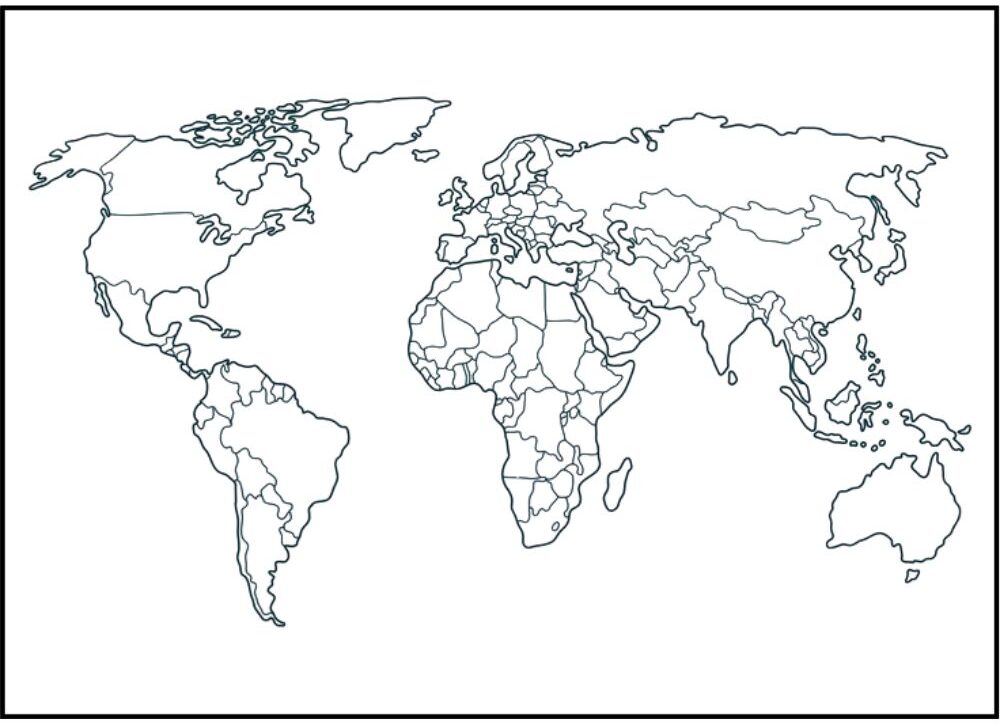World Map without Names is the map where all the countries, continents, and oceans are depicted, but without any of them written on, without any names. Types of this kind of map enable you to view the contours and sizes of land and water without knowing what it is.

It makes you concentrate on the ways the various components of the world relate to each other and the size or magnitudes of the various components, where one is bigger or smaller as compared to the other. You can attempt to guess for yourself what each place is, without the names, and that can be fun and informative.
Free World Map without Names

It is also an easy and hygienic means of viewing the world, making it good for decorating or learning. Even geography can be learned with it to practice, as people can write the names or notes themselves. Generally, a blank world map allows one to visualize and comprehend the world intriguingly with a new and exciting start, and of course, it is done by simply glancing at the contours and boundaries.
Printable World Map without Names

The world map provides an empty canvas of continents and countries of the Earth without a name worksheet, allowing learners to practice their geographical knowledge. It outlines land names and waterways without any labels, encouraging users to identify and label countries, capitals, or regions on their own.
This interactive worksheet is ideal for educational settings, which helps students improve their map skills, memory, and spatial awareness. It promotes active learning and engagement with world geography. Whether used for class activities, homework, or personal practice, this map is a valuable tool that increases the understanding of the world’s geography with hands-on and in a memorable way.
| Continent | Key Countries (no labels on map) | Approximate Location | Relative Shape / Borders |
|---|---|---|---|
| North America | USA, Canada, Mexico | West of Atlantic, east of Pacific | Large landmass with Canada north, USA central, Mexico to the south |
| South America | Brazil, Argentina, Chile, Peru | South of North America | Triangular shape, tapering to southern tip at Chile/Argentina |
| Europe | France, Germany, UK, Italy, Spain, Scandinavia | West of Russia, north of Africa | Dense cluster of small-medium shapes with peninsulas (Italy, Iberia) |
| Africa | Nigeria, South Africa, Egypt, DRC | Below Europe, crossing the Equator | Roughly symmetrical north/south with horn in east (Somalia) |
| Asia | China, India, Russia, Saudi Arabia, Japan | East of Europe, north of Indian Ocean | Very large mass; India a triangle, Arabian peninsula block-shaped |
| Oceania | Australia, Papua New Guinea, New Zealand | Southeast of Asia | Australia large, New Zealand small islands to the southeast |
| Antarctica | No countries (ice-covered) | Southernmost point on globe | Circular landmass around the South Pole |
World Map Without Name List Labeled

A world map without labels provides an empty canvas that highlights continents, countries, and major geographical characteristics. It emphasizes the size and relative positions of landmasses like North and South America, Africa, Europe, Asia, Australia, and Antarctica. The oceans and the seas appear, which outline the vastness of the water bodies of the Earth.
Map of the World without Names

A map of the world without names offers a clean, minimal approach to our planet, which only shows the outline of continents, countries, and oceans. Without a label, it encourages curiosity, learning, and exploration. This type of map is perfect for educational purposes, classroom activities, geography games, or creative projects such as coloring or pin-marking visiting places.
![Blank Map of World [Free Printable Maps]](https://blankmapofworld.com/wp-content/uploads/2025/05/blank-map-logo-1.png)
